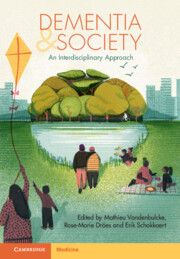Book contents
- Dementia and Society
- Dementia and Society
- Copyright page
- Contents
- Contributors
- Additional material
- Preface
- Chapter 1 Different Perspectives on Dementia
- Chapter 2 From History to Intervention
- Chapter 3 Personhood, Identity and Autonomy
- Chapter 4 Living Meaningfully with Dementia
- Chapter 5 Quality of Life of Persons with Dementia
- Chapter 6 Living with Dementia
- Chapter 7 Informal Care for Persons with Dementia
- Chapter 8 Risk Factors and Non-Pharmacological Prevention of Dementia
- Chapter 9 An Empowering Dementia Environment
- Chapter 10 The Impact of the COVID-19 Pandemic on the Well-Being of People Living with Dementia
- Chapter 11 Care Planning and the Lived Experience of Dementia
- Chapter 12 Societal and Ethical Views on End-of-Life Decisions in Dementia
- Chapter 13 Driving and Dementia
- Chapter 14 Social and Private Costs of Dementia
- Index
- References
Chapter 1 - Different Perspectives on Dementia
Published online by Cambridge University Press: 26 May 2022
- Dementia and Society
- Dementia and Society
- Copyright page
- Contents
- Contributors
- Additional material
- Preface
- Chapter 1 Different Perspectives on Dementia
- Chapter 2 From History to Intervention
- Chapter 3 Personhood, Identity and Autonomy
- Chapter 4 Living Meaningfully with Dementia
- Chapter 5 Quality of Life of Persons with Dementia
- Chapter 6 Living with Dementia
- Chapter 7 Informal Care for Persons with Dementia
- Chapter 8 Risk Factors and Non-Pharmacological Prevention of Dementia
- Chapter 9 An Empowering Dementia Environment
- Chapter 10 The Impact of the COVID-19 Pandemic on the Well-Being of People Living with Dementia
- Chapter 11 Care Planning and the Lived Experience of Dementia
- Chapter 12 Societal and Ethical Views on End-of-Life Decisions in Dementia
- Chapter 13 Driving and Dementia
- Chapter 14 Social and Private Costs of Dementia
- Index
- References
Summary
Cognitive failure and the fear of losing control over one’s life has occupied mankind for centuries. In our chapter we describe the conceptual history of dementia starting with the first written traces from the twenty-fourth century BCE, relating the story of an Egyptian officer who not only developed the inability to remember yesterday but also became more and more childish. Subsequently, we summarize medical discoveries that have allowed cognitive, psychological and behavioral symptoms of dementia to be viewed as a result of brain disease rather than, for instance, witchcraft or ill will. In the context of growing awareness of neuro-pathophysiological mechanisms underlying dementia, associated with postmortem brain research in the late ninettenth century, Alzheimer’s disease became the ‘face’ of dementia for some time. We discuss further developments in the discovery and in the treatment of different types of dementia, also focusing on psychosocial aspects of the disease. These became an important topic of research as pharmacological treatments aimed at curing the neurodegenerative causes of dementia as yet do not exist. AWe compare how different cultures and societies deal with dementia. Finally, the political and societal attempts to promote social inclusion and empowerment of individuals with dementia are summarized.
- Type
- Chapter
- Information
- Dementia and Society , pp. 1 - 24Publisher: Cambridge University PressPrint publication year: 2022

